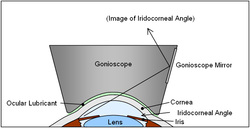
In preparation for the gonioscopy exam, anesthetic drops were administered, and the exam has a thick contact lens placed on the cornea of each eye. The procedure was extremely well tolerated by all our dogs, with no objections to placement of the lens or examination by the vet with a strong light. The vet was using the lens to visualize the iridocorneal angle (see larger picture). This is where the base of the iris attaches to the peripheral cornea and sclera. It is important to examine this part of the anatomy of the eye, because it is where fluid drains from the eye's anterior chamber. If the angle is so narrow that it prevents drainage of fluid from the anterior chamber of the eye, the dog could be at risk to develop glaucoma.
Dr. Ringle classifies the status of the iridocorneal angle as being normal, slightly narrowed, moderately narrowed, or severely narrowed. His recommendation for treatment was for none for a normal angle, optional (i.e. at the owner's discretion) for dogs with a slightly narrowed angle, but strongly recommended use of eye drops to reduce intraocular pressure for dogs with moderately or severely narrowed angles.
We discussed breeding recommendations with him based on particular findings, and he was reluctant to say that all dogs with a narrowed iridocorneal angle should automatically be excluded from breeding programs. His reason for this is that a) there is no good information on the prevalence of narrowed angles in our breed at this time and b) the incidence of glaucoma in Welshies is very low. Not enough breeders and owners are obtaining gonioscopic evaluations of their dogs and publishing this information, and it is entirely possible that there are significant numbers of dogs with narrowed angles being used in breeding programs even now. In fact, he mentioned that it was possible that some degree of narrowed angles may actually be the norm in the breed, since so few dogs are being examined for the status of the iridocorneal angle and there is no preventive breeding program in place except after the fact when glaucoma is identified in bloodlines.
We asked Dr. Ringle about how reliable the test was and how readily it could be performed by other ACVO-certified veterinarians. He was emphatic that all ACVO-certified vets are trained on performing this exam and they are equally competent in interpreting the findings of the exam. He essentially minimized any 'intra-operator' differences between vets in the performance of this test, and felt that was an excuse used to dismiss the value of the test results. Based on my reading of available information, the test itself has some limitations, but for first-level examination it certainly provides useful information. There are new imaging modalities available now should owners wish to pursue further studies, including High Resolution Ultrasound. More information about other imaging studies and the current state of breed specific research about glaucoma can be found in the article Glaucoma in the Bassett Hound.
The current OFA eye examination forms do not have a place to list the status of the iridocorneal angles or results of gonioscopy. I asked Dr. Ringle to use the COMMENTS section of the form to specify the status of the angle that he identified. I will check if this information shows up on the OFA website when the forms are submitted.
Bottom line-folks, it's time to wake up and smell the coffee. There is a need to determine if the WSS gene pool has predominantly normal or narrowed iridocorneal angles. Perhaps we should recommend that gonioscopy become a standard for awarding a CHIC? Remember, when instances of glaucoma are documented it can require huge modifications to a breeding program. But, with testing and evaluation of information, all breeders gain valuable information that can be used to make wise choices. The test itself is not costly or dangerous, and it increases the level of understanding of our dogs and their genetic predisposition to disease. I don't really see a difference between this test and the TGAA testing we all routinely perform.
So, what do you think-is it time to recommend that we add gonioscopy to the CHIC testing requirements? Or at least add it to the list of things we should check for routinely, the way thyroid testing has become ubiquitous? I look forward to your comments!
 RSS Feed
RSS Feed